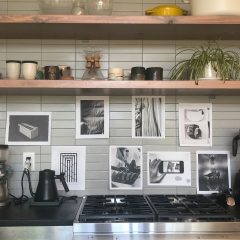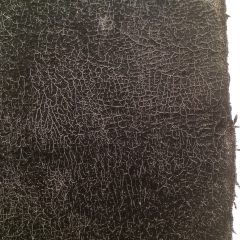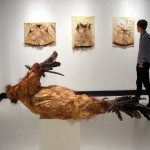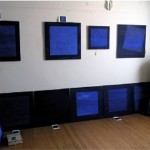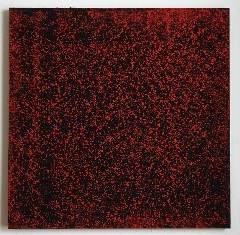
Additive Subtractive Primaries–Red, 2005-2006, oil stick on linen over birch panel, 23 7/8 x 23 7/8 inches
We’re all living at supersonic speeds. Think about the movies we see. Compare them to the movies of 40 years earlier. The old ones seem pokey. We have gotten so used to the tight cutting that we accept eclipsed time as a given in our mental geography.
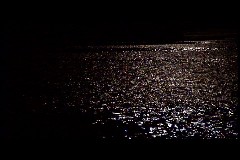
Moonlight, 29 August 2004)video still
The artist team Kocot and Hatton, husband and wife, are working in the opposite direction. Their videos of natural phenomena are real time. And their paintings and drawings are records of time spent making marks during time borrowed from sleep, in the middle of the night, when they are half awake, half asleep.
The resulting work–18 drawings and paintings, plus a boxed collection of 13 videos and an index disk of the videos–is at Larry Becker through May 20th.
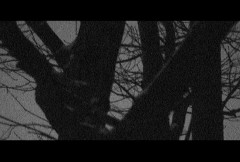
Tsunami (26 December 2004) video still
When I stopped in, the two artists were sitting in the gallery ready to talk about their work to a tour group coming through–as well as anyone else who had questions. Tom Hatton mentioned when I asked some questions about the team’s “Split” paintings, that they were post-tsunami and the split represented a shift from pre- and post-tsunami time. He said that the tsunami had so far-reaching an impact that one of their videos caught an upward movement of trees when the tsunami hit (I’m not sure if he meant the tsunami itself or the earthquake that generated it).
That sort of close observation of nature, that slowing down and observing the tiniest details, is usually the preserve of naturalists and hunters, people who take their cues not from other people but from the part of the world that’s unfiltered by human interventions.
The results serve as reminders of our place in the real universe. And they also deliver sleep-time thoughts, which often get lost in the daily logic of making decisions and moving on to the next one.
I don’t really know how significant it is that the subliminal, sleepy mind’s processes are getting recorded in this work. But I do know that the results are powerful images that seduce and slow the observation process. The work brings me to a pace that I rarely visit in my waking hours.
Although at first glance, the work may seem rarified, it is not. At the same time that it’s atmospheric, giving a sense of weather and light and time, it is in touch with the large events that strike multiple lives. The artists began using black gesso grounds after 9/11.
In all this seriousness, when I exclaimed, “Black gesso?” I thought it quite funny when Hatton exclaimed, “Black gesso is one of the greatest inventions of recent times.” He added that it is a Golden’s product.
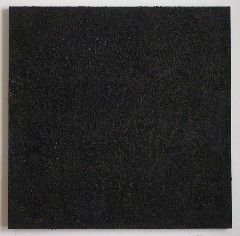
Additive Subjective Properties–Yellow’s Shadow, 2005-2006, oil stick on linen over birch panel, 23 7/8 x 23 7/8 inches
The black, chunky oil stick markings on the black gesso are highlighted in some of the paintings with colored oil stick. While all of the paintings in the oil stick series have a cosmic quality, the color highlights offer eye candy too. But I loved them all. The dense lipstick-red on black was the first of them I saw, definitely the Marilyn Monroe of the lot. But the one that ultimately stole my heart had purple highlights on the raised areas, and an aura of yellow over black on the background, suggesting the subtle colors of the night, transformed by moonlight or even electric light leaching from buildings. I’m thinking Humphrey Bogart, smoking.
The paintings that are split, are divided either by a seam in the linen, or by a line where the linen shows through. Either way, that line is a time demarcation. And the importance of time is also recorded in the titles of many of the works in the exhibit. The titles “Breath #3” or “2 May-11 May 2005 (red code)” all speak to the subject. The same for the videos, which are named partly by dates.
The drawings, shaky ink lines, keep promising to reveal the logic behind them, but ultimately do not. I liked looking for that logic, and I liked thinking about the time involved–the time to make the marks, the idea of Marcia Kocot’s time and of Tom Hatton’s time, each of them following the rules they agreed upon before hand.
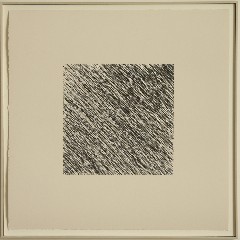
Kocot and Hatton, 28 May – 31 May 2005 (green code), 2005, ink on rag paper, 15 3/8 x 15 3/8 inches
These artists are smart and thoughtful. Although they follow rules, the rules are inspired by ideas that come from someplace larger than just process. And that larger place, whether you call it spiritual or nature-related or conceptual or subliminal and meditative, also fits into a stream of artmaking that pushes representation aside and finds another sort of representation, a representation of meaning.
In a way, I am not looking for some magic from the idea that the paintings and drawings are marks of the sleepy minds of Marsha Kocot and Tom Hatton, although I’m glad to know it, because it explains the methodology to a degree. What I do care about is how the conscious mind makes the decisions to use the sleepy mind in an unexpected way, to decide to record what that time of night and semi-consciousness has to offer–and then to make something of it that engages the eye and the mind and has something to say about today’s world as we experience it.


